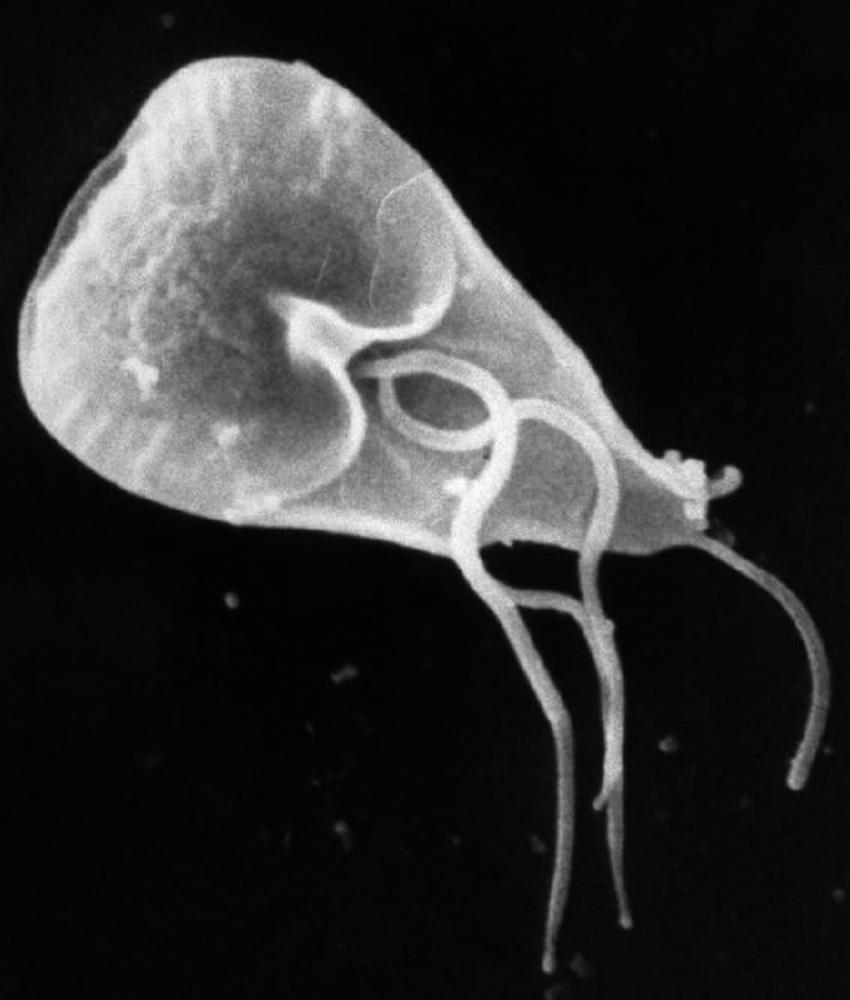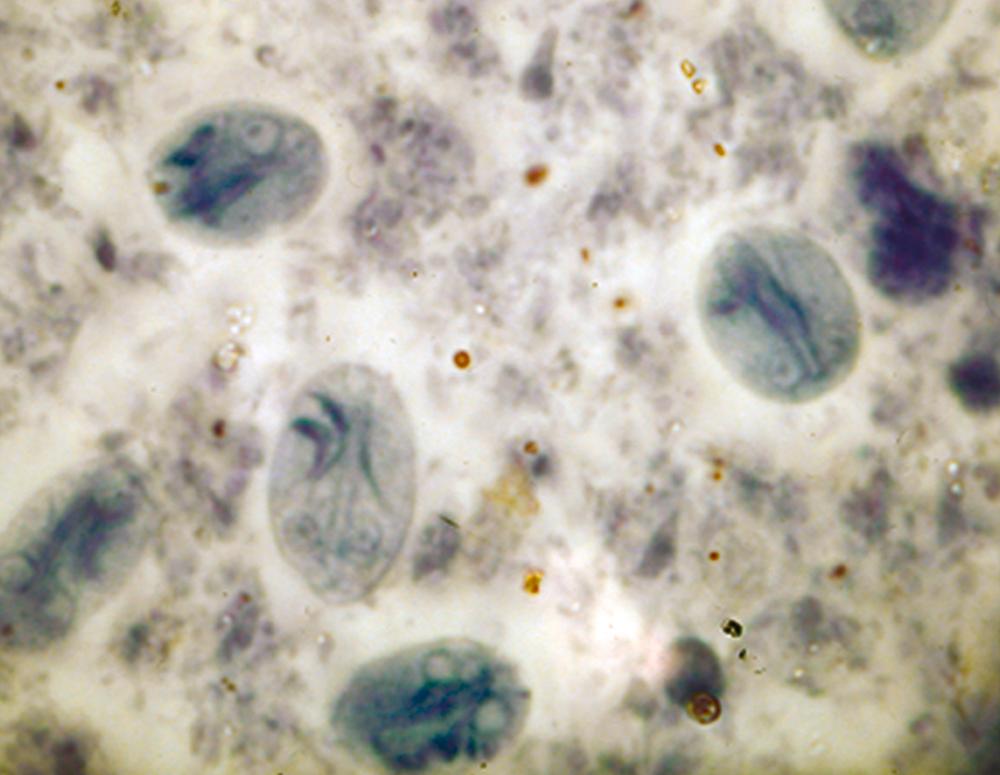Physical Address
304 North Cardinal St.
Dorchester Center, MA 02124
Giardia lamblia ( Giardia duodenalis, Giardia intestinalis ) is a ubiquitous, small intestinal protozoan parasite of humans and other mammals. It is the most common parasitic infection of the gastrointestinal tract in the United States as well as worldwide, and it is responsible for outbreaks of diarrhea and sporadic endemic disease. ,
Giardia has a simple life cycle. The trophozoite, which is 9 to 21 µm long, 5 to 15 µm wide, and 2 to 4 µm thick ( Fig. 322-1 ), resides in the small intestine and is responsible for the manifestations of disease. It has four pairs of flagella, two nuclei, and a ventral sucking disc by which it may adhere to intestinal epithelial cells. The dorsal surface is pear shaped and bilaterally symmetrical, with the two highly characteristic nuclei best visualized after staining. In the lower small intestine, the trophozoite develops into an environmentally resistant cyst ( Fig. 322-2 ). Detection of soluble cyst wall proteins in the feces forms the basis of many stool antigen assays.


Excreted cysts, which are mature and infectious, are oval and about 8 to 12 µm in length and 7 to 10 µm in width (see Fig. 322-2 ). After ingestion and exposure to acid and proteases in the stomach and intestines, they excyst in the small intestine, where each cyst forms two trophozoites, which quickly divide. In vitro, trophozoites double in number every 6 hours for the fastest growing isolates.
A number of morphologically identical but genetically distinct Giardia infect humans and animals and are divided into eight assemblages. Humans, as well as some animals, are typically infected with either assemblage A or B; other assemblages occasionally infect humans. , Assemblages A and B are genetically and biologically diverse and appear to be two separate species.
Giardia is well adapted to its existence as a parasite. It has two equal functioning nuclei and lacks mitochondria and peroxisomes. It has a simplified metabolism and is dependent on the host for nutrients such as purines, pyrimidines, cysteine, phospholipids, cholesterol, and most amino acids except for alanine. The WB isolate, assemblage A, has a compact genome (11.7 Mb) with unusually short promoters. The parasite’s rigid cytoskeleton is composed of unique families of structural proteins and carbohydrates.
Giardia is the only bowel-dwelling parasite that undergoes antigenic variation. Only one of a family of about 250 variant-specific proteins (VSPs) is expressed on the surface of the trophozoite at a time. Both immune and biologic selection of trophozoites that express specific VSPs occurs in humans and animals with giardiasis. Expressed VSPs must be compatible with the host’s intestinal environment; antibodies to VSPs are inhibitory or cytotoxic. Whereas all VSPs are transcribed, all but one of the transcripts are eliminated by RNA interference–based mechanisms, thereby resulting in expression of a single VSP surface protein. Exactly how selection and switching occur is unclear.
Giardia is among the most common parasitic infections of humans. It is highly infectious, and cysts are frequently excreted in large numbers (as high as 10 7 cysts per gram of feces), especially in young children. Cysts can survive for months in cold water, are relatively resistant to chlorination, but are intolerant of desiccation and heat compared with the ova of cryptosporidia ( Chapter 321 ) and helminths. Experimentally, between 10 and 100 cysts are sufficient to establish infection. Consequently, ingestion of water or food that contains low levels of contamination can result in infection.
The overall incidence rate is about 6 cases per 100,000 population in the United States, and approximately 20,000 cases are reported annually. However actual infections may exceed 1 million per year because of underreporting.
Infections are most common in young children and are more frequent in summer and fall months, possibly due to increased travel and exposure to environmental water during the warmer months. In low-income, highly endemic regions, almost all children are infected by 2 to 3 years of age, about 20% of them persistently. In these settings simultaneous infection with other enteric pathogens is common.
Giardiasis is acquired after ingestion of contaminated water or food or through person-to-person contact. Before the advent of modern water treatment methods, large outbreaks in high-income countries such as the United States occurred after ingestion of contaminated drinking water obtained from surface sources such as reservoirs, lakes, and mountain streams. Although wastewater treatment plants may not remove all Giardia from these effluents, ingestion of contaminated recreational water from pools or lakes is now a more common source of outbreaks. Outbreaks from contaminated food or infected food handlers are well described. Currently, only 1 to 2% of giardiasis cases are associated with identified outbreaks. Backpackers who ingest untreated surface water are at risk.
Worldwide, person-to-person transmission is the most common source of infection, especially in daycare centers, among family members with infected children, and following sexual practices that lead to fecal-oral contact. Although partial immunity can develop in previously exposed adults, reinfection after treatment in children is common in highly endemic areas. Longer-term travel, particularly to South Asia, increases the risk of giardiasis. For the returned traveler ( Chapter 265 ) with intermittent or persistent diarrhea, giardiasis should be excluded. Giardia infections tend to be severe in patients who have common variable immunodeficiency but are not more common in persons with selective immunoglobulin (Ig) A deficiency.
Become a Clinical Tree membership for Full access and enjoy Unlimited articles
If you are a member. Log in here